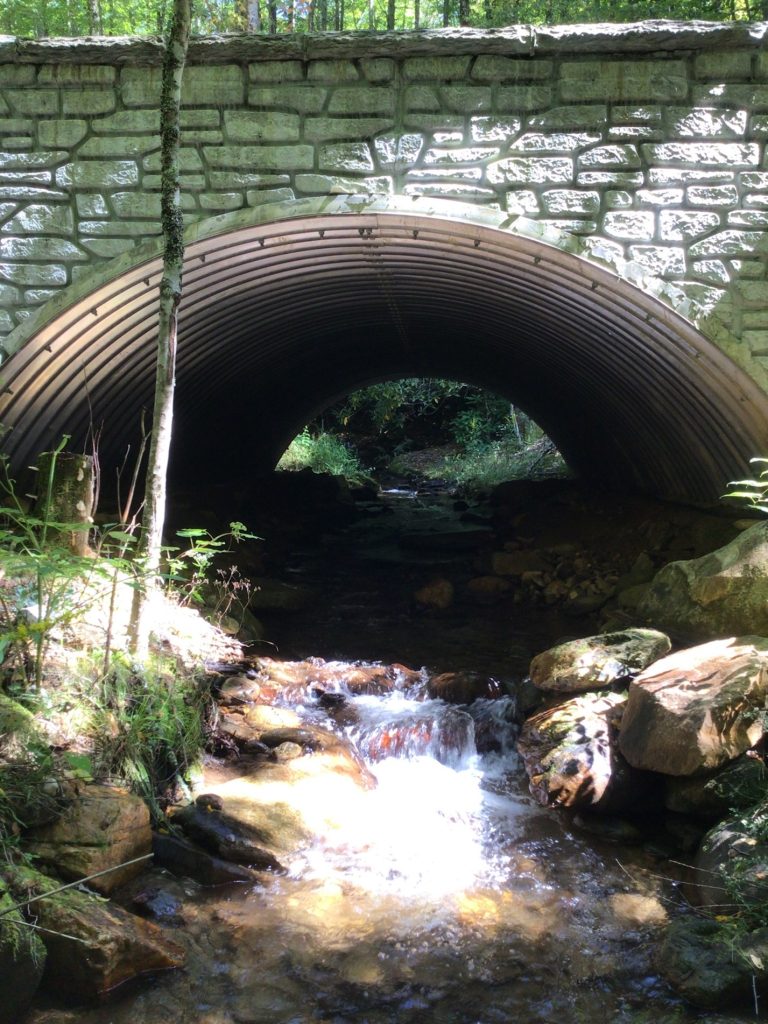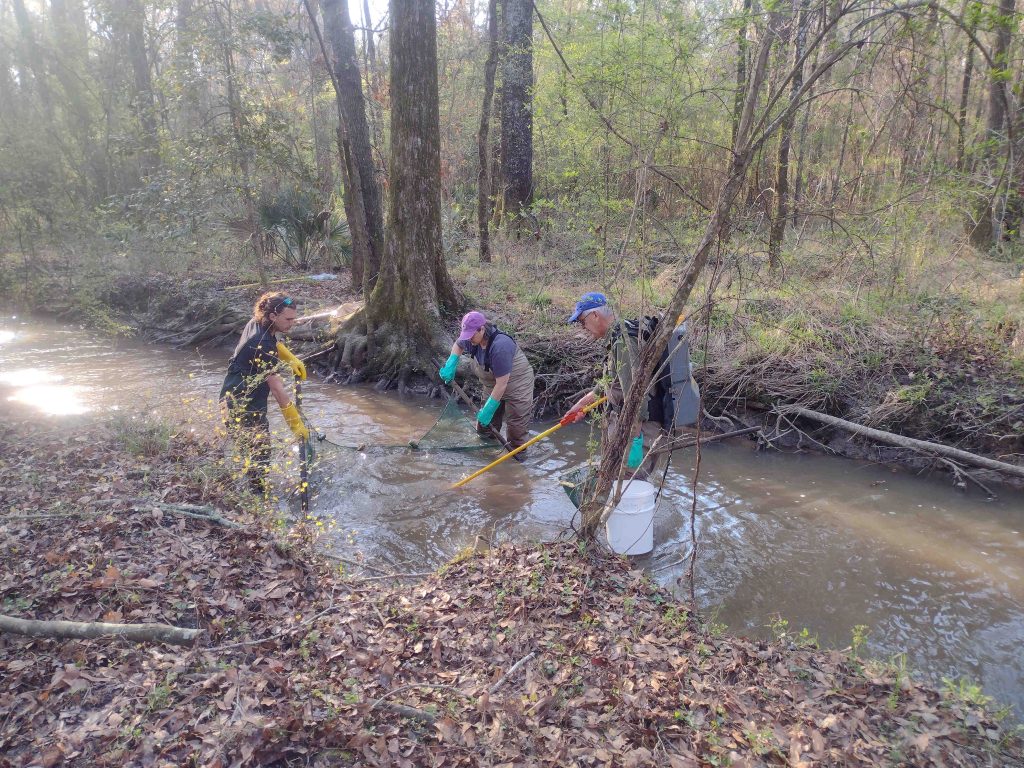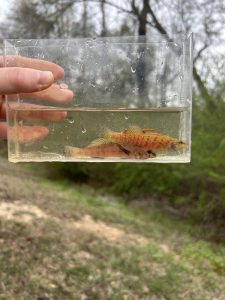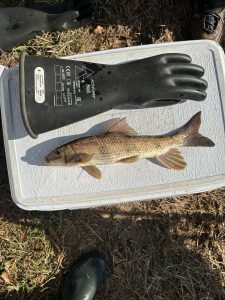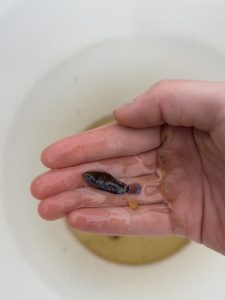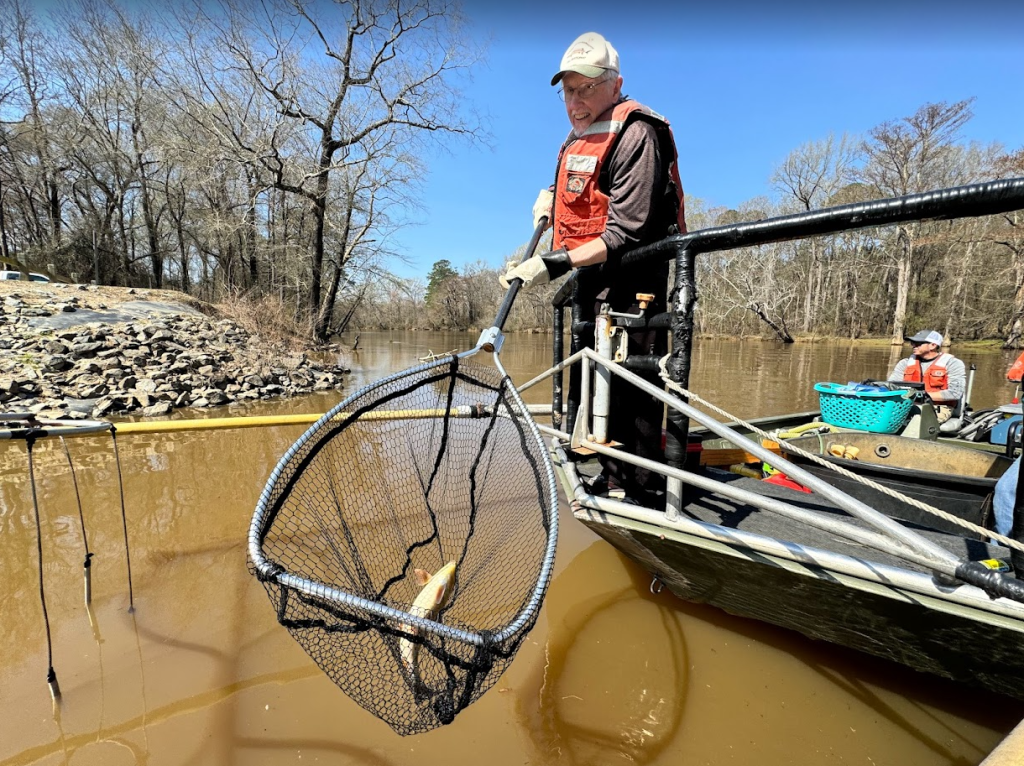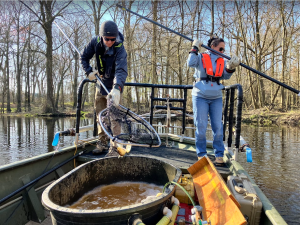Spring 2024 Newsletter

Quick Content Links
- President’s Message
- Treasurer’s Report
- NCAFS Annual Meeting Recap
- National Forests in North Carolina Improve Habitat for the Southern Appalachian Brook Trout
- A Week in the Eastern Georgia Coastal Plain
- Updates from the NCSU Student Fisheries Society
- A Spring Excursion for the NCfishes.com Team
- Good Work! – Recent Publications by NCAFS Members
- Stories of Interest
- Call to Action!
- Valuable Links
President’s Message
Happy spring!
I want to thank everyone who was able to make it out to the February meeting in Sylva. This meeting wouldn’t have been possible without all the great help we had from Bryn Tracy (program and logistics), Brena Jones (webmaster/registration), Chantelle Rondel (catering and logistics), Keith Gibbs (transportation and logistics), Seth Mycko (workshop and A/V), NCAFS ExCom, and countless other volunteers. It was our largest meeting on record with 32 students, 7 retirees, and 108 total folks who registered. We put a lot of effort into increasing student participation/involvement and improving diversity of presentations. I think our hard work paid off. We had ~40 oral and 11 poster presentations that highlighted not only the great work being done with fisheries in NC, but also the diversity of fisheries perspectives we have in NCAFS from all over the state. Our varied interests, experience, and expertise in fisheries is as good as it gets, and I encourage folks to continue to learn, grow, and collaborate with each other throughout the rest of the year.
As the weather continues to warm up and our spring migratory spawners start to head upstream, I’d like y’all to remember this famous quote from one of my personal heroes:
“When the buds start a poppin’, the suckers start a knockin’.” – Duke Hollison, PhD.
Luke
Submitted by Luke Etchison, NCAFS President
Treasurer’s Report
Balances as of March 22, 2023
NCAFS Wells Fargo Checking Account: $5,604.99
SDAFS 2025 Meeting Checking Account: $464.00
NCAFS PayPal Account: $132.29
RRCC Wells Fargo Saving Account: $3,356.79
Edward Jones Ichthus (Student) Fund: $30,461.32
Edward Jones General Fund: $74,694.82
As of March 2024, the NC Chapter of the American Fisheries Society has a total of 50 NC AFS only members and 59 NC AFS and AFS members for a total of 109 active members. 15 are students, 83 are professional members, and 11 are retirees or lifetime members. Thank you to everyone who paid their dues!
We are planning the 2025 SDAFS meeting! Mark your calendars for February 17-21, 2025, and join us in Asheville! We are beginning to fundraise for the meeting. If you have any ideas for sponsors or would like to volunteer on the Finance Committee please reach out to [email protected] or [email protected].
For a detailed report of NCAFS’s finances in 2023, and other chapter information, please reference the 2024 Business Meeting Minutes, which will be available on our website for review soon. For any questions regarding meeting minutes, finances, or procedures, please contact Casey Joubert, Secretary/Treasurer for NCAFS ([email protected]).
Casey
Submitted by Casey Joubert, NCAFS Secretary-Treasurer
NCAFS Annual Meeting Recap
Our annual meeting was held February 27-29 in Sylva, NC. We had a great meeting with 108 attendees (32 students, 7 retirees, 58 professionals, and 11 sponsor registrations) and 42 presentations. Tyler Muller was awarded the Richard L. Noble Best Student Paper award for his presentation: “A Taxonomic Revision of the Pirate Perches, Aphredoderus”. The W. Don Baker Memorial Award for Best Professional Paper went to Casey Joubert for her presentation “Untangling Angler Opinions: North Carolina Reservoir Striped Bass Fisheries”. Sheryl Bryan was awarded the Fred A. Harris Fisheries Conservation Award, and Kevin Dockendorf was honored with the Jerry R. Finke Distinguished Service Award. Congratulations to all of the award recipients and to the meeting organizers (Luke, Bryn, Chantelle, Brena, Keith, and Seth) for a Chapter meeting well done!
Thank you to our sponsors—Three Oaks Engineering, TranSystems, Duke Energy, RK&K, Dewberry, Equinox Environmental, Jennings Environmental, The Nature Conservancy, Wildlands Engineering Inc., and EnviroScience Inc.—and thank you to all the members for making this another successful and fun meeting!
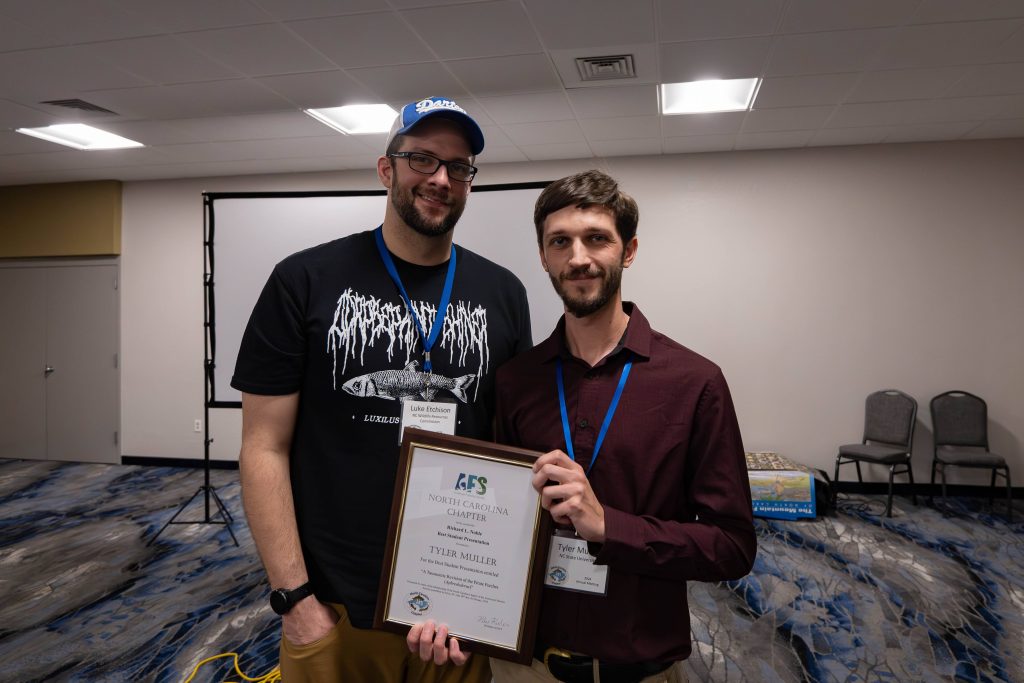
NCAFS president Luke Etchison (l) awarding Tyler Muller the Richard L. Noble Best Student Presentation. Photo credit: Scott Smith.
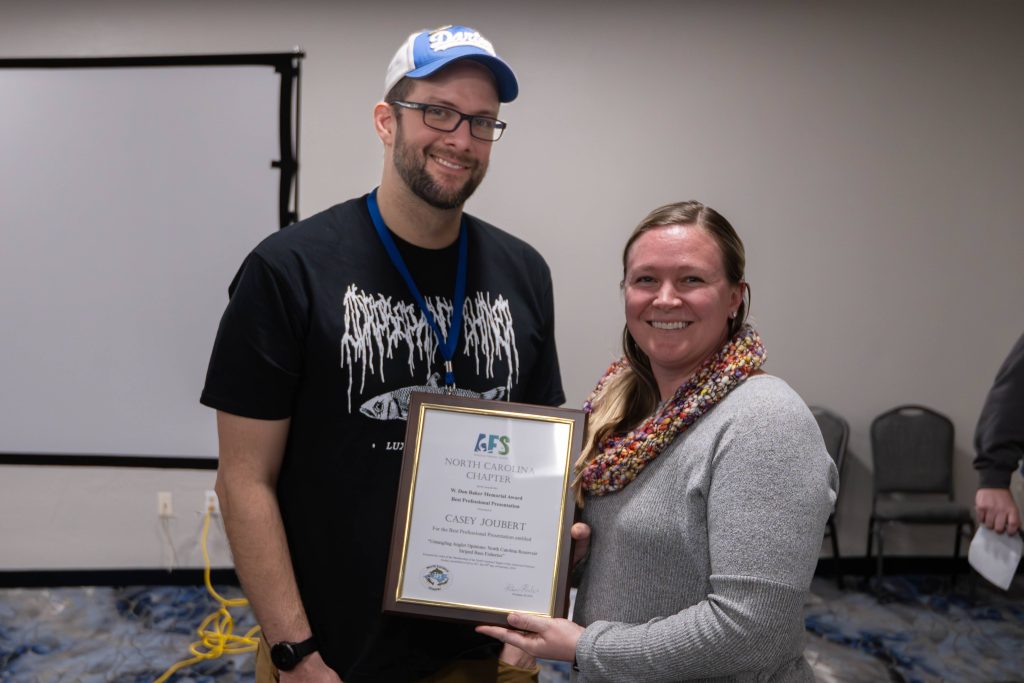
NCAFS President Luke Etchison (l) awarding Casey Joubert the W. Don Baker Memorial Award for Best Professional Presentation. Photo credit: Scott Smith.
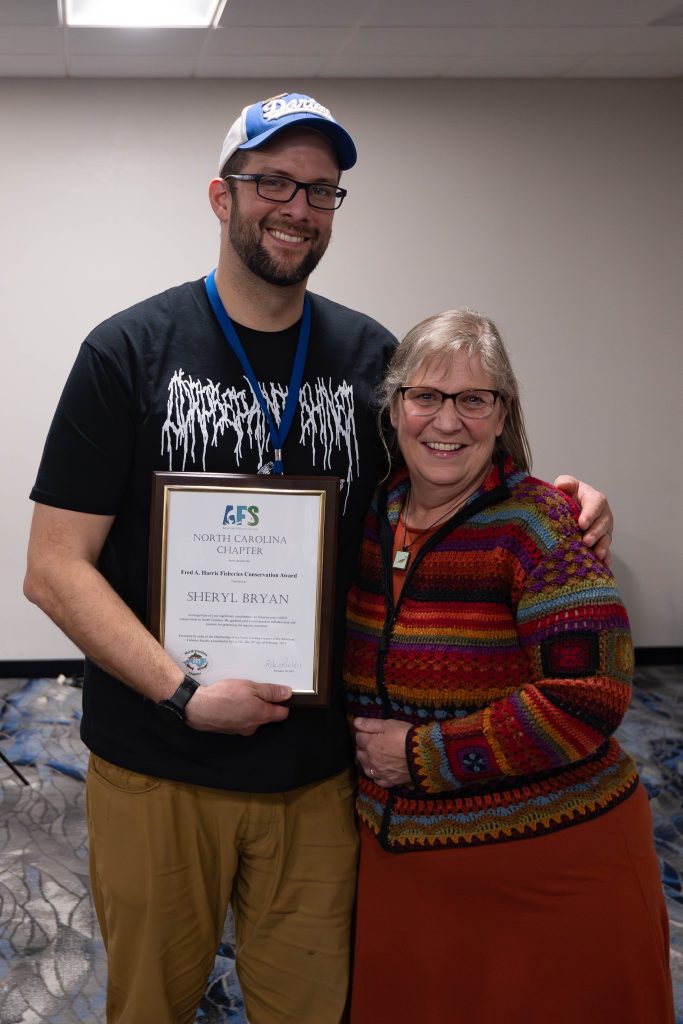
NCAFS president Luke Etchison (l) awarding Sheryl Bryan the Fred A. Harris Fisheries Conservation Award. Photo credit: Scott Smith.
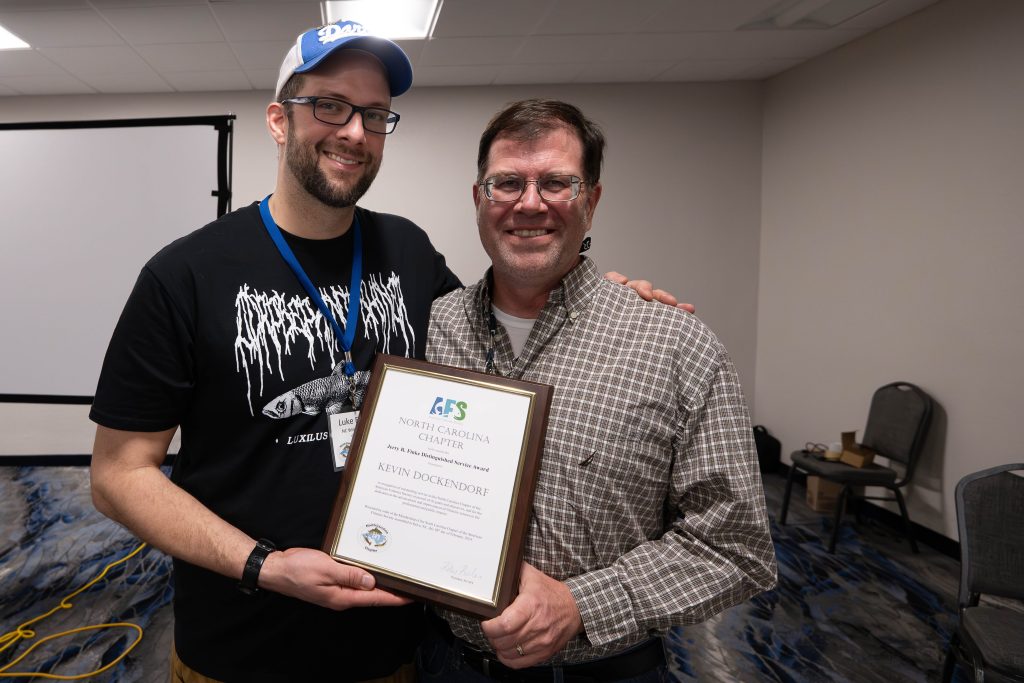
NCAFS president Luke Etchison (l) awarding Kevin Dockendorf the Jerry R. Finke Distinguished Service Award. Photo credit: Scott Smith.
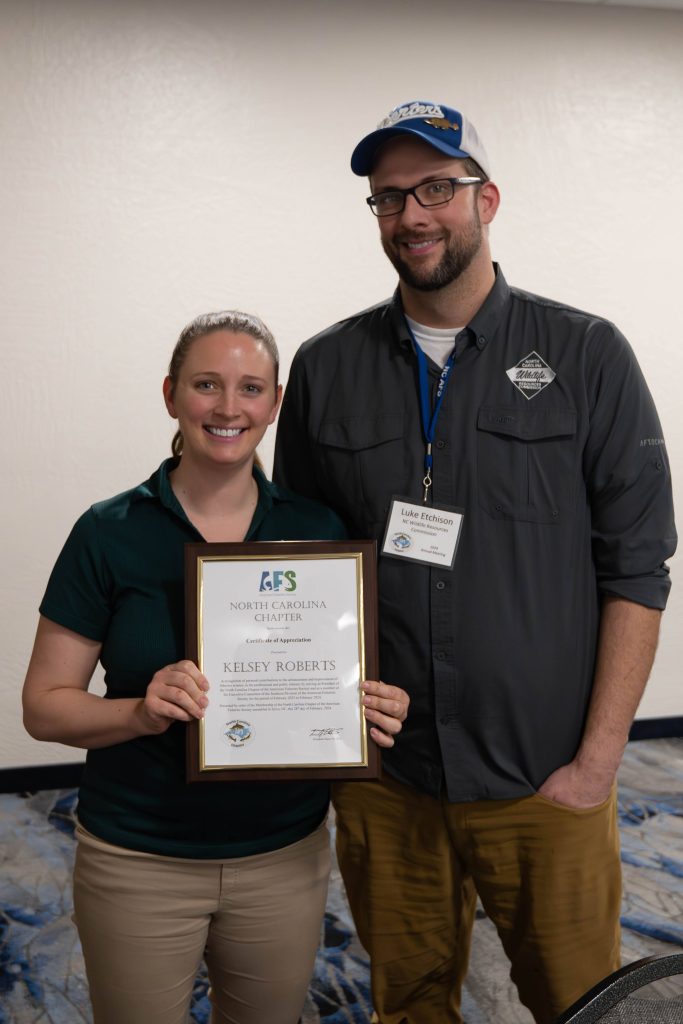
Last but not least! NCAFS president Luke Etchison (on the right this time) recognized outgoing NCAFS president Kelsey Roberts. Photo credit: Scott Smith.
Submitted by Casey Joubert and Scott Smith
National Forests in North Carolina Improve Habitat for the Southern Appalachian Brook Trout
As you read this, iconic North Carolina native Brook Trout, Salvelinus fontinalis, swim in the cold, clean waters of mountain streams in the Nantahala and Pisgah National Forests. These streams provide some of the highest quality waters within western North Carolina. As these streams flow, they are sometimes crossed by roads with culverts which can impede fish movement. Culverts, and other sources of habitat fragmentation, can cause a loss of genetic diversity by isolating fish populations. Upstream populations can also be lost during extreme droughts or floods.
The U.S. Forest Service has worked with partner organizations and community members to reduce habitat fragmentation at road crossings and improve habitat for our native southern Appalachian Brook Trout. Over the past 20 years, these partnerships have worked on more than 20 sites across the Nantahala and Pisgah National Forests. We’ve worked to update older, restrictive culverts with new Aquatic Organism Passages, known as AOPs. These crossings are built with bottomless arches to allow more naturalized stream flow and channels for native fish. The arch is bolted to concrete footers while the natural stream bed is allowed to flow through the crossing. Over 30 stream miles of fragmented habitat have been restored by removing artificial barriers.
These improvements are the fruit of a long-standing partnership between the U.S. Forest Service in North Carolina, the North Carolina Wildlife Resources Commission, and Trout Unlimited. We truly value what each of our partners bring to watershed and wildlife management on the National Forests in North Carolina. They support us through project management, technical expertise, funding, and volunteers which multiplies all of our efforts for our state’s only native trout species. The partnership’s latest accomplishments include Brook Trout habitat improvements at Alarka Creek and Cedar Rock Creek.
We look forward to building on this partnership foundation and working with new local watershed groups or agencies. A lot of work remains to be completed but we plan to work together to open more miles of streams for Brook Trout so future generations can visit and cast a fly in the hopes of catching a true North Carolina native Brook Trout.
Submitted by Lauren Wilson, USFS
A Week in the Eastern Georgia Coastal Plain
With the help of Erimi Kendrick, Sean Sullivan, Gabriela Hogue, and Bryn Tracy, NC Museum of Natural Science’s Fish Curator Lily Hughes and her PhD student Tyler Muller spent Spring Break in Georgia collecting lowland fishes for Tyler’s dissertation. Spring showers held out for the week allowing electrofishing in the Savannah, Ogeechee, Altamaha, Satilla, Ocmulgee, Oconee and Ohoopee Rivers. Despite the dry conditions, preceding rain left many of the rivers swollen and intermittent and low order streams stole the show.
Lily caught every Spotted Sucker of the trip, including one by hand, and every Creek Chubsucker was thoroughly examined by the sucker lip expert, Erimi. Sean netted an impressive Everglades Pygmy Sunfish from under a log which caused a photo frenzy and significant dinner delays. Gabriela and Bryn pioneered through the unsampled Ocmulgee tributaries upstream from Dublin and found a pristine forested stream with several species of darter and the only Speckled Madtoms of the trip.
Fishes encountered include: Warmouth, Dollar Sunfish, Bluegill, Redear Sunfish, Spotted Sunfish, Flier, Black Crappie, Mud Sunfish, Bluespotted Sunfish, Banded Sunfish, Banded Pygmy Sunfish, Everglades Pygmy Sunfish, Redfin Pickerel, Chain Pickerel, Eastern Mudminnow, Sooty-banded Darter, Christmas Darter, Swamp Darter, Southern Tessellated Darter, Bowfin, Blackstripe Pirate Perch, Lowland Pirate Perch, Mud Sunfish, Eastern Creek Chubsucker, Lake Chubsucker, Spotted Sucker, Eastern Mosquitofish, Inland Silverside, Green Silverside, Lined Topminnow, Golden Topminnow, Taillight Shiner, Coastal Shiner, Lowland Shiner, Ironcolor Shiner, Yellowfin Shiner, Snail Bullhead, Yellow Bullhead, Tadpole Madtom and Freckled Madtom. Other encounters included Sirens, Amphiumas, a River Frog tadpole and Alligators.
Casualties of the trip include a brand-new pair of waders and linemen’s gloves – both presumably ripped by the most dense riparian thorny plants the Southeast has to offer, and the egos of three unnamed collectors who wound up briefly lost in the woods less than 100 yards from their pull off.
Tyler’s research seeks to explain how Gulf slope species have colonized the Southern Atlantic Coastal Plain.
The team would like to thank Corey Dunn from the NC Cooperative Fish and Wildlife Research Unit for loaning us a second backpack shocker for this trip.
Submitted by Tyler Muller
Updates from the NCSU Student Fisheries Society
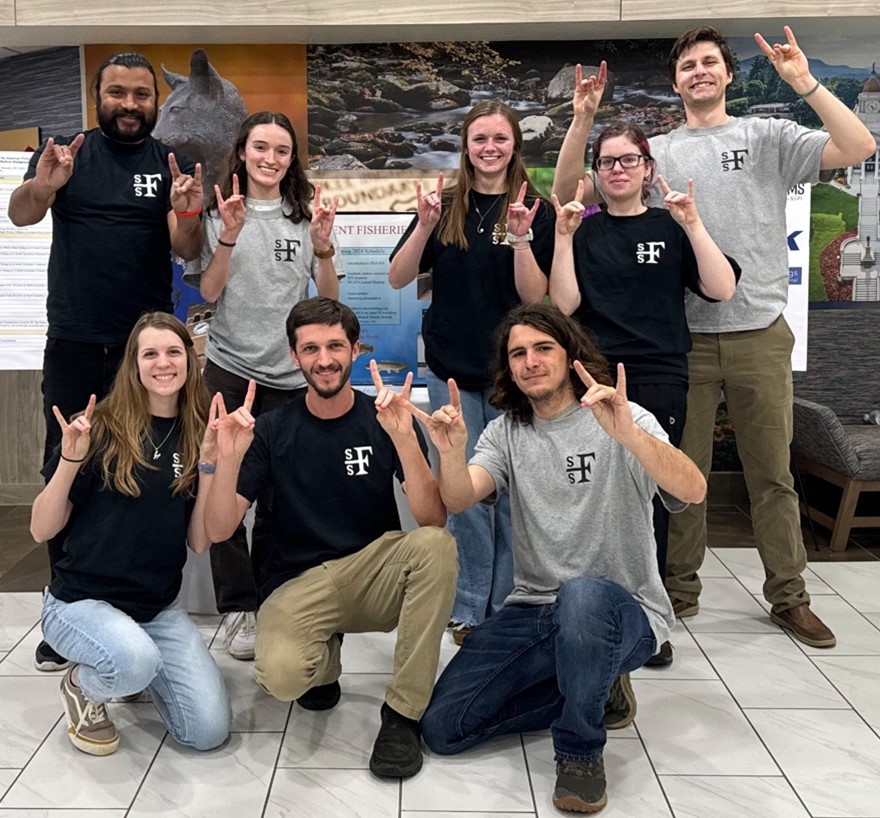
Front row, left to right – Devin, Tyler, and Sean. Back row, left to right, Amit, Madison, Kendall, Caspian, and Matthew.
The Student Fisheries Society (SFS) is recharged going in to 2024 with new officers and a new advisor (Corey Dunn). The subunit made a strong showing at the 2024 NCAFS Chapter Meeting in Sylva and due to the Chapter’s generosity was able to raise ~$1800 which will be used to fund projects and travel awards during the coming year. Congratulations to SFS co-president Tyler Muller who won the Richard L. Noble Best Student Paper award for his presentation: “A Taxonomic Revision of the Pirate Perches, Aphredoderus”. No more Pirate Perch, A. sayanus, in North Carolina; its new moniker is Blackstripe Pirate Perch, A. ornatus!
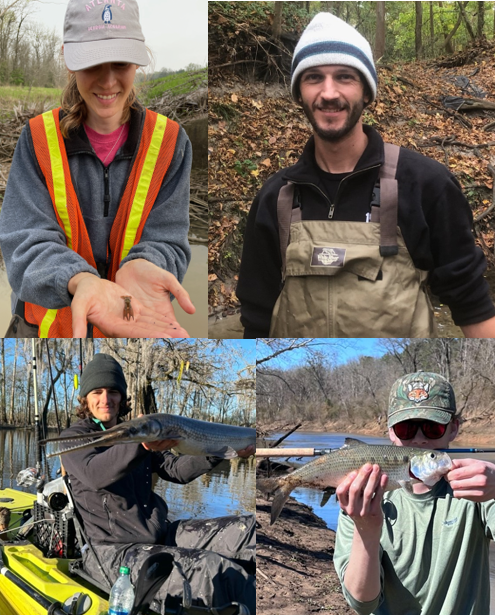
Clockwise from top left: Co-President Devin Raburn, Co-President Tyler Muller, Vice-President/Treasurer Tucker Gaddy, and Secretary Sean Sullivan.
Contributed by Bryn H. Tracy and the NCSU Student Fisheries Society
A Spring Excursion for the NCfishes.com Team
On March 13th, Fritz Rohde and Scott Smith made the two-hour drive to meet NCWRC’s TD Van Middlesworth and Heather Evans on the Neuse River near Goldsboro. TD and Heather were looking to sample in and around Falling Creek, near Cox’s Ferry Boating Access Area, and Fritz and Scott were after a decent Alewife photo. Luckily it didn’t take long before the Alewife showed up, occasionally mixed in with plenty of Hickory Shad.
In the end, we were able to photograph Alewife, Threadfin Shad, Hickory Shad, Redear Sunfish, Bluegill, Warmouth, and a Notchlip Redhorse for the website. Heather and TD also caught the largest Bowfin I had ever seen, but unfortunately we were completely unprepared to photograph such a lively and large fish. Fritz casually mentioned giving it another shock for good measure, but I’m pretty sure it was in jest.
Submitted by Scott Smith
Good Work! – Recent Publications by NCAFS Members
Dunn, C. G., D. A. Schumann, M. E. Colvin, L. J. Sleezer, M. Wagner, D. T. Jones-Farrand, E. Rivenbark, S. McRae, and K. Evans. 2024. Using resiliency, redundancy, and representation in a Bayesian belief network to assess imperilment of riverine fishes. Ecosphere. https://doi.org/10.1002/ecs2.4738
Hightower, J. E. 2024. A Bayesian introduction to fish population analysis. https://bookdown.org/Joseph_Hightower/bayesianfish/
McIver, J. K., W. G. Cope, R. B. Bringolf, T. J. Kwak, B. Watson, A. Maynard, and R. Mair. 2023. Assessing the toxicity of sea salt to early life stages of freshwater mussels: implications for sea level rise in coastal rivers. Environmental Toxicology and Chemistry 42(11): 2478-2489.
Muller, T. A., and A. M. Simons. 2024. Taxonomic revision of the Pirate Perches, Aphredoderus, (Percopsiformes: Aphredoderidae) with descriptions of two new species. Zootaxa.
Pandolfo, T. J., W. G. Cope, D. M. Weaver, and T. J. Kwak. 2024. Thermal threats to freshwater mussels: an empirical stream assessment. Diversity. https://doi.org/10.3390/d16010037
Polera, M. E., P. M. Erwin, M. A. Mallin, B. C. Saul, H. D. Synan, and L. B. Cahoon. 2024. Microcystis aeruginosa blooms in an unlikely riverine ecosystem: a waste treatment lagoon source? Water. DOI: 10.14294/WATER.2023.4
Submitted by the NCAFS Newsletter Review Team
Stories of Interest
Conflicting Mullet, Flounder seasons signal bigger problems
Part 1 of WRC and NCDMF news
Agencies’ joint rules conflict
Part 2 of WRC and NCDMF news
Agencies acknowledge confusion
Part 3 of WRC and NCDMF news
Red handfish brought into captivity
Species endangered due to limited range and marine heat waves
NCSU program to restore oysters and improve diversity
NOAA grant funding efforts to improve representation of underrepresented groups
Largest dam removal in US history begins
Removal of large dams is possible.
Wildlife Commission welcomes new advisors
Todd Ewing and David Cooper join the Nongame Wildlife Advisory Committee
The Billion dollar impact of NC’s trout fishery
Job security for Jake Rash!
Wanchese fish company closes after 88 years of operation
Cheap fish, climate change, bad weather, fuel prices, Oregon Inlet, and regulations are blamed
Submitted by the NCAFS Newsletter Review Team
Call to Action!
If you want to contribute, have a story idea or would like us to include something in next quarter’s newsletter, email Kyle Rachels at [email protected] or give him a call at 252-548-4938.
Also, if you want to become more involved with one of the many great NCAFS committees then please check this link for information about each one, contacts, etc., https://nc.fisheries.org/who-we-are/committees/
 Valuable Links
Valuable Links
The American Fisheries Society Home Page offers a wealth of links to assist you in your fishy endeavors. This and archived NCAFS newsletters, along with links, chapter information, and upcoming meetings, can be found here on our own website.

